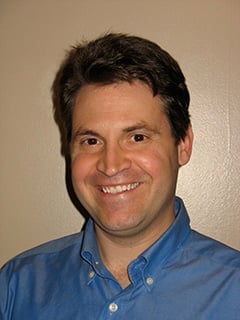2002 Graduate Student Scholarship, 2008 New Century Scholars Research Grant
Questions and Answers

John McCarthy’s (second) career began with a question: What happens when you can’t use your voice in the way you want to?
Actually, the question arose from McCarthy’s first career in music. It was during a singing lesson he was teaching that he encountered a student with voice pathology. As he learned more about the field of communication disorders and continued to teach a person who stuttered, McCarthy realized that “a key part of an individual’s identity is communication. When I learned next that there were people with communication disorders so severe that they could not use their voice for everyday communication,” he remembers. “I was hooked.” So began career number two.
During the next step in his professional development he worked as a speech-language pathologist in the schools after studying in a federally funded program for training in Augmentative and Alternative Communication (AAC). It was at this point that McCarthy formulated another career-altering question: “How can a computer ‘voice’ be accessed in the most efficient and personalized way?” That’s the question his work, from that time on, has been dedicated to answering.
It is also the question that led directly to the research for which McCarthy received support from the ASHFoundation, “Improving Auditory Scanning Interfaces in AAC Devices.” His study concerned those individuals who require AAC and who also have concomitant physical disabilities that prevent them from using computer-based systems. Research at the time was available on the use of AAC for individuals with physical disabilities but there was a lack of information on methods that aimed to improve auditory scanning of AAC devices for people with visual impairments.
McCarthy tested two potential solutions: using environmental sounds to represent items, such as the sound of a clock ticking to represent a clock, and providing spatial cues regarding the organization of items, such as presenting auditory information and altering temporal and spectral features so that sounds are heard from various directions. The results of the study showed a benefit in reaction time for sounds but not for words and revealed that sounds were less accurate than words.
McCarthy is still seeking answers. His search has led to a focus on developing programs, devices, and opportunities for those individuals with communication disorders who have visual and motor impairments. From his creation of an online program to teach problem-solving using AAC to working on a system to assist children with disabilities in their understanding of computer interfaces to the development of an auditory scanning system for those with visual impairments, McCarthy has sought, from the time he began asking those important questions, to make communication available to everyone.
“My ASHFoundation awards have helped to advance both my career and my research,” McCarthy says. “The student support early on helped me pursue my research interests beyond the subject of my dissertation.” Later, as a faculty member—he is currently associate professor and associate director of the Communication Sciences and Disorders School of Rehabilitation and Communication Sciences at Ohio University—the ASHFoundation funding allowed him to collaborate with colleagues in audiology. “This collaboration was productive,” he believes, “not only in research but in developing and pursuing issues related to interprofessional education.” And, we have to believe, in finding answers to questions.
View More Recipient Spotlights